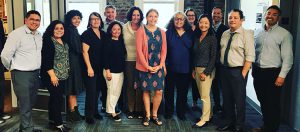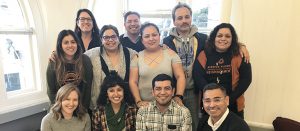Co-authored by:
Associate Director Liz Cortez, Mission Promise Neighborhood
Early Learning Program Manager Ada Alvarado Freund, Mission Promise Neighborhood
Abriendo Puertas Professional Learning Community includes the following partners:
Felton Institute
Good Samaritan Family Resource Center
Homeless Prenatal Program
Mission Neighborhood Centers
San Francisco Unified School District – Early Education Department
Support for Families
Introduction
Abriendo Puertas/Opening Doors’ mission is to “support parents in their roles as family leader and as their child’s first and most influential teacher in a home that is their child’s first school.” This two-generation approach builds parent leadership skills and knowledge to promote family well-being and positive education outcomes for children. It is the nation’s first evidence-based comprehensive training program developed by and for Latino parents with children ages 0-5.
Since starting in 2007, Abriendo Puertas/Opening Doors has trained over 1,800 facilitators in more than 500 organizations, impacting over 80,000 parents/families across the country. The curriculum focuses on early childhood development, early literacy, health, social-emotional well-being, the use of media and technology, numeracy, school preparation and parent advocacy. In 2012, University of California, Berkeley’s Institute of Human Development identified that participants had made remarkable growth across all areas of assessment. In the analysis, the largest effects were found in the following areas: school preparation; health development; parenting; and advocacy.
Within the Mission District of San Francisco, a collective of Latino family-serving organizations that are part of the Mission Promise Neighborhood initiative (MPN) — and historically part of First 5 San Francisco’s Family Resource Center initiative — are working together to increase the number of families that access Abriendo Puertas at the neighborhood level.
MPN serves as a backbone organization that supports the collaborative efforts of partner organizations within the Mission District, all working to improve school readiness outcomes and support families. The population of Latinos in the Mission District is approximately 21,000 with 1,700 children ages 0-5. Latino families in the Mission have a median income of $25,000, compared to the San Francisco household median of $78,000.
After learning that turnover of Abriendo Puertas facilitators is a real challenge within our partner network, MPN and partner First 5 San Francisco hosted a community training to rebuild the capacity of these organizations. We also wanted to grow the number of organizations offering Abriendo Puertas. In early 2017, 14 facilitators, representing six organizations, participated in the training provided by Abriendo Puertas. We realized that to maintain the momentum and desire to offer more sessions to families, a one-time training was not going to be enough. So we created a professional learning community and started meeting every two months to share best practices and support each other in growing the work.
The group identified a few results and has mostly focused their collective work on two of them:
- More families have access to Abriendo Puertas in the Mission District and San Francisco.
- Families feel connected to their Abriendo Puertas family after the series.
Our collective impact
MPN serves as a backbone organization in many ways, including: coordinating the trainings for existing and new facilitators in the community; facilitating the professional learning community for facilitators; and collecting and analyzing the data from various partners to tell a collective story. We have been able to increase the number of organizations offering Abriendo Puertas by 133 percent (from three in 2016 to seven in 2017) and all of these organizations participate in the bimonthly professional learning community to share data and tell a collective story for the community. Our goals for achieving communitywide impact include breaking organizational silos to work together to ensure that more families are accessing Abriendo Puertas, and that when families participate they stay connected to other families and build a community of support.
By the numbers:
- 133 percent increase in organizations offering Abriendo Puertas while adding 14 new facilitators.
- 100 percent of organizations offering Abriendo Puertas are participating in the Professional Learning Community and sharing data to tell a collective story.
- 159 percent increase in Abriendo Puertas participation.
Building the professional learning community
Bringing people together to work on a common result takes coordination support from a lead organization; as such, we work to build relationships and develop trust. This helps with keeping a group engaged over time. Coordination support is critical to the planning of the meetings, the follow up on commitments and the collection of data to tell the collective story. People are busy and therefore appreciate effective meetings: We use the Results-Based Facilitation framework for planning and running our meetings, thereby ensuring that we are all clear on why we are coming together and what the next steps will be. We are also creative in our approach to communicating across the group. In addition to holding meetings every two-months for one-and-a-half hours — complemented by one-on-one check-ins — we stay connected via a Facebook group page. We ensure that all of our communication is consistently and constantly messaging the vision and agreements for scaling this work.
The MPN Abriendo Puertas learning community includes 100 percent of the organizations in the community that offer Abriendo Puertas, and the facilitators collectively developed group results or goals and how they will measure progress. At this moment, the data that is shared includes the number of participants and the number/percent that graduate from a series. In addition to having a collective goal of increasing the number of participants, the professional learning community is a space for facilitators to support each other and share best practices. We have seen organizations pair up to co-facilitate sessions and have also seen newer facilitators learning from more-seasoned facilitators. The group has developed a year-round community calendar that informs families of where a series is being offered across organizations.
Organizations in our community have a high level of staff turnover, making it difficult to stay aligned to reach our goals. In addition, facilitators have multiple demands on their time and therefore joining meetings outside of their own organization is often challenging. We find it key that supervisors — and the leadership of each organization which is participating — is fully supportive of the facilitators that attend the meetings and understand the goals of the group.
Results of working together
Since working together to increase capacity in facilitators and new organizations offering Abriendo Puertas in early 2017 and the creation of the professional learning community, we have seen a year-by-year increase in the amount of participants that are engaging in the program. As seen in Figure 1, we have seen participation increase by 159 percent since the beginning of 2017.

In addition to engaging in the program, we want participants to feel connected to their Abriendo Puertas family after they graduate, so we hosted our first “Fiesta Comunitaria Abriendo Puertas” in September of 2018. There were 289 family members who came out to celebrate family leadership and promote social connection among families. The professional learning community conducted a post-event survey to gather feedback from families. One parent shared, “I learned that the Abriendo Puertas program is more than a parenting program … it is also a movement at the national level.”
One story: Olga, Abriendo Puertas facilitator and professional learning community member
What is it like being part of this learning community? How have you felt supported as a first-time facilitator and the only one offering it through your organization?
“The provider learning group meetings have been really useful because they give me the opportunity to keep connected to providers of other organizations, to know what they are doing in the community, the classes they are planning to offer in the future and we can discuss relevant topics related to Abriendo Puertas and the scaling of the work citywide.
“Since it was the first time that I facilitated — and also the first time that our agency implemented this program — it would have been helpful to have had more staff trained within our agency. Being a part of the professional learning community was supportive and crucial, since any questions that I had, they were there to answer and, more importantly, to connect me with a facilitator from another agency that co-facilitated a series with me.”
Next Steps to Deepen our Work
Focusing on the pre-/post-assessment
We have learned that organizations use the participant pre- and post-assessment in different ways, and some not at all. Partner organizations have found the assessment too long, so participants find it difficult to answer. Some organizations have created their own pre- and post-assessment questions, while others have broken down the questions into separate pre- and post-assessments to give to participants by session. For example, one partner uses creative ways of capturing the increase in knowledge, using a learning tree with each leaf documenting a participant’s thoughts and learnings after a session. Not having the same pre- and post-assessment data across organizations has limited the kind of analysis that we can do. We will continue to find ways of aligning our assessments to demonstrate our collective story and impact.
Participation versus graduation
In addition to scaling so that more families access Abriendo Puertas, we want more families to complete all of the session, and at least enough sessions to graduate. In 2019, some partners will be focusing on graduating more families by developing more intentional strategies for retention and engagement of participants. We want all families to feel recognized for participating and we will promote certificates for participation and certificates for graduation.
Linkage to advocacy and leadership development opportunities after the series
We want to follow up with families after they have graduated to see how they are doing with their goal-setting and how we can support their advocacy and leadership goals. We have learned that some families are starting to take on advocacy and leadership roles within their schools and in their community. We want to document and celebrate how they are getting involved and putting their advocacy skills to practice.
We will continue to build the facilitator capacity in our community by offering additional trainings for our partners. This will allow us to continue to scale the work in the Mission District, and across San Francisco. Working collectively in a professional learning community allows us to support each other while trying to achieve these big goals of ensuring that more families participate and graduate from Abriendo Puertas, plus that they feel connected to their Abriendo Puertas family after they graduate.
_____________________________
About Mission Promise Neighborhood
The Mission Promise Neighborhood is a citywide community partnership that was created to support kids and families living, working, and attending school in the Mission District. MPN partners provide a network of support services to help families achieve economic stability and the tools needed to support their children’s academic achievement, creating a brighter future for the whole Mission community.
 Mission Promise Neighborhood (MPN) works daily to provide wraparound services to strengthen families.
Mission Promise Neighborhood (MPN) works daily to provide wraparound services to strengthen families. 

 2018 could have been our final year.
2018 could have been our final year. 
 La misión de la Iniciativa Comunidad Promesa de la Mission vive en la familia Lourdes Velazquez – ya que son un ejemplo de lo que pasa cuando una comunidad trabaja colectivamente para apoyar y abogar por una familia. Juntos con La Raza Centro Legal, MEDA, Causa Justa, Mission Graduates y con otros
La misión de la Iniciativa Comunidad Promesa de la Mission vive en la familia Lourdes Velazquez – ya que son un ejemplo de lo que pasa cuando una comunidad trabaja colectivamente para apoyar y abogar por una familia. Juntos con La Raza Centro Legal, MEDA, Causa Justa, Mission Graduates y con otros  by MPN Director Richard Raya
by MPN Director Richard Raya In December 2012, MEDA worked with city agencies and 25 neighborhood partners to replicate New York’s successful Harlem Children’s Zone in the Mission District of San Francisco. The goal of the Mission Promise Neighborhood (MPN) is to guide students on a cradle-to-college-to-career continuum, while helping their families achieve economic success.
In December 2012, MEDA worked with city agencies and 25 neighborhood partners to replicate New York’s successful Harlem Children’s Zone in the Mission District of San Francisco. The goal of the Mission Promise Neighborhood (MPN) is to guide students on a cradle-to-college-to-career continuum, while helping their families achieve economic success. At crowd-filled
At crowd-filled 




